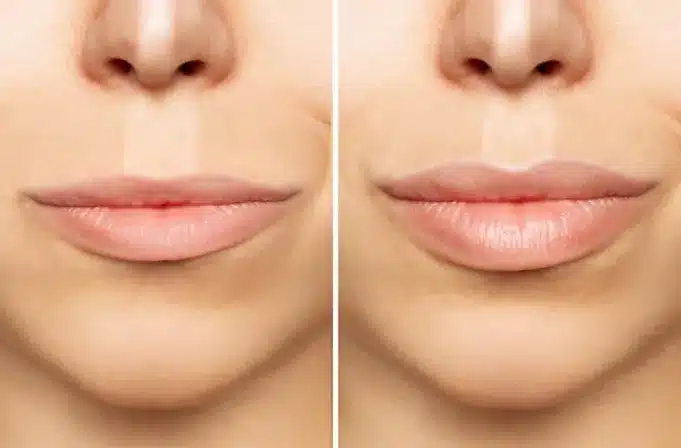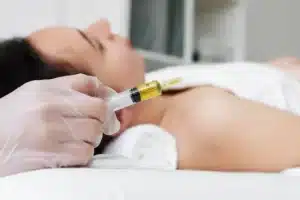Lip augmentation, a popular cosmetic procedure, encompasses various techniques aimed at enhancing lip volume and shape. Common methods include lip plumping, achieved through the use of injectable fillers or lip injections, which offer temporary or semi-permanent results. These techniques, integral to lip augmentation, provide individuals with the opportunity to achieve fuller and more defined lips, enhancing their facial aesthetics and boosting confidence.
What is Lip Augmentation
It’s a cosmetic procedure aimed at enhancing the size and shape of the lips. It involves various techniques and methods to achieve the desired outcome, such as increasing lip volume, smoothing out wrinkles, and creating more pronounced lip contours.
The procedure can be performed using injectable fillers or implants, and the choice of method depends on the individual’s preferences, goals, and the medical professional’s recommendations.
Steps of Lip Augmentation
Consultation
The process begins with a consultation with a qualified medical professional. The patient’s goals, preferences, and medical history are discussed during this consultation to determine the most suitable approach.
Anesthesia
Depending on the chosen method, local anesthesia or numbing cream may be applied to minimize discomfort during the procedure.
Injection or Implant Placement
If using injectable fillers, the chosen filler substance (often hyaluronic acid) is carefully injected into specific areas of the lips. If implants are chosen, a small incision is made, and the implant is inserted.
Lip cosmetic surgery has gained significant popularity in recent years as a way to enhance the appearance of the lips. From adding volume and definition to reshaping and rejuvenating the lips, various procedures are available to help individuals achieve their desired results. In this comprehensive guide, we will explore different types of lip cosmetic surgery.
Sculpting and Molding
The medical professional sculpts and molds the injected substance or implant to achieve the desired shape and volume. This step requires precision to create natural-looking results.
Procedure
Injectable fillers or fat transfer are injected into the lips under local anesthesia, followed by post-procedure care to manage swelling and ensure optimal results.
Injectable Fillers
The filler is injected strategically into the lips to achieve the desired volume and shape. The practitioner may massage the area to ensure even distribution.
Fat Transfer
Fat is harvested from a donor area, purified, and injected into the lips.
Lip Implants
A small incision is made at the corner of the mouth, and the implant is inserted and positioned.
Symmetry and Balance
Ensuring symmetry and balance between the upper and lower lips is crucial for a harmonious outcome. The medical professional carefully adjusts the placement to achieve this balance.
Recovery and Aftercare
After the procedure, patients are given instructions for proper aftercare, including avoiding certain activities, applying ice to reduce swelling, and using prescribed medications if necessary.
Clinic contact number: +989371200167
Ideal Candidates for Lip Augmentation
The best candidates are individuals who desire subtle or noticeable enhancement of their lips, have realistic expectations, and are in good overall health. Those with naturally thin lips, uneven lip contours, or age-related volume loss often benefit from this procedure.
Age Considerations
it is generally suitable for adults. Most professionals recommend waiting until the late teens or early twenties before considering the procedure, as the face develops during adolescence.

Benefits of Lip Augmentation
- Enhanced Confidence: Lip augmentation can boost self-confidence by giving patients the fuller lips they desire, increasing self-esteem and a more positive self-image.
Lip reduction surgery is a cosmetic procedure designed to decrease the size and volume of the lips, creating a more proportionate and balanced appearance.
This surgical intervention aims to enhance facial harmony and boost self-confidence by addressing concerns about excessively large or disproportionate lips. Over the years, lip reduction surgery has become an effective solution for individuals seeking a more balanced facial aesthetic.
- Youthful Appearance: As people age, their lips may lose volume and definition. Lip augmentation can restore a more youthful appearance by reversing the effects of aging and creating plumper lips.
- Natural-Looking Results: Skilled medical professionals can achieve natural-looking results that enhance the lips without appearing augmented or overdone.
- Customizable: Lip augmentation procedures are highly customizable to meet the individual’s preferences and goals. Patients can choose the level of enhancement they want, from subtle to more noticeable changes.
- Quick and Minimally Invasive: Most augmentation procedures are quick and minimally invasive, often taking less than an hour to complete. This allows patients to undergo the procedure during their lunch break or on a day off.
- Minimal Downtime: Recovery time after augmentation is usually short, and patients can often return to their normal activities within a few days. This makes it a convenient option for individuals with busy schedules.
- Immediate Results: Many patients notice immediate results after the procedure, with their lips appearing fuller and more defined immediately.
- Reversible Options: Some fillers used in lip augmentation can be dissolved if the patient is unsatisfied with the results or wants to return to their original appearance.
- Gradual Enhancement: For those who prefer a more gradual change, lip augmentation procedures can be done incrementally over multiple sessions to achieve the desired look over time.
- Minimal Scarring: Non-surgical methods of lip augmentation, such as injectable fillers, do not involve incisions, which means there is no visible scarring after the procedure.
Your healthcare provider will give you specific instructions on how best to prepare. A few weeks before the procedure, you’ll need to stop smoking. Cleveland Clinic

Clinic contact number: +989371200167
Naturally fuller lips
Achieving naturally fuller lips without the need for invasive procedures is possible through various non-surgical methods and lifestyle practices. One approach involves using hydrating lip balms or lip treatments containing ingredients like hyaluronic acid, shea butter, or vitamin E, which help to moisturize and plump the lips. Regular exfoliation with a gentle lip scrub can also remove dead skin cells and stimulate blood circulation, resulting in a smoother and more voluminous lip appearance. Additionally, incorporating lip exercises into your daily routine, such as puckering or smiling widely, can help strengthen the muscles around the lips and improve their tone and fullness over time.
Furthermore, maintaining overall skin health and hydration contributes to the appearance of fuller lips. Staying adequately hydrated by drinking plenty of water throughout the day helps to keep the lips hydrated and prevents dryness or chapping. Protecting the lips from sun damage by applying a lip balm with SPF or wearing a wide-brimmed hat when outdoors can prevent premature aging and maintain lip fullness. Additionally, adopting a balanced diet rich in fruits, vegetables, and omega-3 fatty acids supports skin health and collagen production, which can indirectly contribute to plumper lips and a more youthful appearance.
Moreover, embracing makeup techniques can create the illusion of naturally fuller lips. Using a lip liner that matches the natural lip color and slightly overdrawing the lip line can enhance the lip shape and create the appearance of increased volume. Applying a lip gloss or lip plumper with light-reflecting particles to the center of the lips adds dimension and creates a fuller, more luscious look. Choosing lip colors with lighter or nude shades can also make the lips appear larger and more prominent. By combining these non-invasive methods and lifestyle practices, individuals can achieve naturally fuller lips that complement their overall facial features and enhance their confidence and self-esteem.
There are a few reasons to resist kissing after getting filler in your lips, the first being the risk of infection. “Anytime you’re putting a needle through the skin, you want to avoid anything that can cause infection or inflammation for 12 to 24 hours. That includes kissing,” says Dr. David Shafer, a board-certified plastic surgeon in New York City. You need to allow time for the holes from the punctures to heal so that bacteria can’t travel through them, adds Dr. Michael Schwartz, a board-certified plastic surgeon in Westlake Village, California.
The second reason is to allow enough time for the filler to fully integrate with the lip tissue, as the pressure from kissing can (potentially) cause the filler to migrate. “This can lead to unevenness, where one side of the lips is fuller than the other because the product has moved to that side. The filler can also travel past the upper lip to above the Cupid’s bow, creating a ‘monkey mouth’ appearance. In these cases, your provider may need to dissolve the migrated filler and start over,” Dr. Schwartz explains.
For that reason, Dr. Jessie Cheung, a board-certified dermatologist in Willowbrook, Illinois, advises waiting even longer to kiss after filler injections. She says three days is an adequate amount of time, so long as you’re keeping the kissing technique gentle. (In case you’re wondering: oral sex puts even more pressure on the lips, so the doctors we spoke with suggest waiting three to seven days in order to reduce the likelihood of filler migration.)
The Rise of Lip Augmentation
Lip augmentation, a sought-after cosmetic procedure, has garnered significant attention from leading institutions such as the Mayo Clinic and Harvard Medical School, where experts like Dr. Jeffrey Spiegel have made notable contributions to the field. With advancements in techniques and materials, lip augmentation has become more refined, offering patients safer and more natural-looking results. Notably, the Cleveland Clinic has emerged as a prominent center for cosmetic procedures, including lip augmentation, with its state-of-the-art facilities and a team of experienced practitioners dedicated to enhancing patients’ aesthetic features.
In recent years, the demand for lip augmentation has surged dramatically, with statistics revealing a significant uptick in procedures performed globally. According to data from the American Society of Plastic Surgeons, lip augmentation procedures have experienced a steady increase, with a staggering 30% rise reported in the past five years alone. Moreover, the accessibility of non-invasive techniques such as injectable fillers has contributed to this growth, making lip enhancement more popular among a diverse demographic. This surge in demand underscores the evolving perceptions of beauty and the increasing acceptance of cosmetic enhancements as a means of self-expression and confidence-building.

Am I a Candidate for Dermal Fillers?
Determining whether you are a suitable candidate for dermal fillers depends on various factors, including your aesthetic goals, medical history, and skin condition. Dermal fillers are commonly used to address signs of aging, such as fine lines, wrinkles, and loss of volume, as well as to enhance facial contours and features. Ideal candidates for dermal fillers are individuals seeking to rejuvenate their appearance without undergoing invasive surgery. They may have concerns about volume loss, sagging skin, or asymmetry in specific areas of the face, such as the cheeks, lips, or nasolabial folds.
Additionally, candidates for dermal fillers should be in good overall health and have realistic expectations about the outcomes of the procedure. It’s essential to discuss your medical history, including any allergies, skin conditions, or previous cosmetic treatments, with a qualified healthcare provider during a consultation. Certain medical conditions or medications may affect your suitability for dermal fillers or increase the risk of complications. Your healthcare provider will assess your candidacy for dermal fillers based on factors such as skin elasticity, bone structure, and desired treatment outcomes.
Furthermore, candidates for dermal fillers should have a positive attitude and commitment to maintaining their results through proper skincare and follow-up treatments. While dermal fillers offer temporary enhancement of facial features, regular maintenance injections may be necessary to sustain the desired outcomes over time. It’s essential to have open communication with your healthcare provider and collaborate on a personalized treatment plan that aligns with your aesthetic goals and lifestyle. By considering these factors and consulting with a qualified provider, you can determine whether dermal fillers are the right option for achieving your desired aesthetic enhancements safely and effectively.

Types of Lip Fillers
There are several types of lip fillers available, each with its own unique composition, characteristics, and benefits. One common type of lip filler is hyaluronic acid (HA) fillers, which are derived from a naturally occurring substance in the body. HA fillers, such as Juvéderm and Restylane, are popular choices for lip augmentation due to their ability to provide natural-looking results, add volume, and enhance lip contour. These fillers are biocompatible and typically offer temporary results, lasting several months to a year before gradually being metabolized by the body.
Another type of lip filler is collagen-based fillers, which contain collagen sourced from either human or bovine collagen. While collagen fillers were once widely used for lip augmentation, they have become less common in recent years due to the emergence of newer and more advanced filler options. Collagen fillers may provide temporary enhancement to the lips, but their effects tend to be shorter-lived compared to HA fillers, lasting only a few months before requiring touch-up treatments.
Additionally, there are synthetic fillers, such as poly-L-lactic acid (PLLA) or calcium hydroxyapatite (Cahak) fillers, which stimulate collagen production and promote long-lasting volume restoration in the lips. These fillers offer semi-permanent to long-lasting results, with effects lasting up to two years or more in some cases. Synthetic fillers are suitable for individuals seeking durable lip augmentation and may be preferred for those looking to minimize the frequency of maintenance treatments. However, it’s essential to consult with a qualified healthcare provider to determine the most appropriate type of lip filler based on your individual needs, desired outcomes, and medical history.
Clinic contact number: +989371200167
Risks of Lip Augmentation
1. Swelling and Bruising: Common temporary side effects after the procedure.
2. Uneven Results: Achieving perfect symmetry can be challenging.
3. Allergic Reactions: Some individuals might have allergic reactions to filler substances.
4. Infection: Any procedure involving incisions carries a risk of infection.
5. Filler Migration: Fillers may move from the injection site.
6. Unwanted Appearance: Results may not meet the patient’s expectations.
7. Numbness: Temporary numbness or loss of sensation can occur.
8. Scarring: Surgical procedures carry a risk of scarring.
9. Implant Issues: Implants can shift or cause discomfort.
10. Longevity Variability: Results can vary in how long they last.

Summary
In conclusion, lip augmentation stands as a testament to the advancements in cosmetic surgery, offering individuals the opportunity to enhance their facial features and boost self-confidence. Through techniques such as lip plumping, achieved via lip fillers or injections, individuals can achieve fuller and more defined lips, addressing concerns about volume or asymmetry. These procedures, integral to lip enhancement, have become increasingly accessible and refined, allowing for natural-looking results with minimal downtime. As the field of cosmetic surgery continues to evolve, lip augmentation remains a popular choice for those seeking to enhance their appearance and achieve their aesthetic goals.
FAQs
1. What is lip augmentation? Lip augmentation is a cosmetic procedure aimed at enhancing the size, shape, and appearance of the lips. It involves various techniques, such as injectable fillers, implants, or surgical procedures, to increase lip volume, improve contour, and address asymmetry.
2. What are the different types of lip augmentation? Lip augmentation can be achieved through injectable fillers, such as hyaluronic acid-based products, fat grafting, or collagen injections. Surgical options include lip implants, lip lifts, or vermilion advancements. Each technique offers unique benefits and considerations based on individual preferences and desired outcomes.
3. Who is a suitable candidate for lip augmentation? Suitable candidates for lip augmentation are individuals seeking to enhance the appearance of their lips, address thinning lips due to aging, or correct asymmetry or irregularities in lip shape. Candidates should be in good overall health and have realistic expectations about the outcomes of the procedure.
4. What are the benefits of lip augmentation?
- Enhanced lip volume and definition
- Improved lip symmetry and proportion
- Reduction of fine lines and wrinkles around the lips
- Correction of asymmetry or irregularities in lip shape
- Youthful and rejuvenated lip appearance
- Customizable results tailored to individual preferences.
- Minimal downtime compared to surgical procedures.
- Temporary or permanent options to suit varying needs.
- Boost in self-confidence and self-esteem.
- Long-lasting aesthetic enhancement with proper maintenance.
5. How long do the results of lip augmentation last? The duration of lip augmentation results depends on the specific technique used and individual factors such as metabolism and lifestyle habits. Injectable fillers typically offer temporary results lasting several months to a year, while surgical procedures or permanent implants provide longer lasting or permanent enhancement.
Lip Augmentation: Surgery, Fat Transfer, Fillers, Side Effects (clevelandclinic.org)
How Long to Wait to Kiss After Every Lip Procedure | RealSelf News



